

Nikon / Nikkor (APS-C) Lens Tests. Photozone: All Tests / Reviews. Nikon AF-S DX 17-55mm f/2.8G IF-ED. List of Nikon compatible lenses with integrated autofocus-motor. The following list of Nikon F-mount lenses with integrated autofocus motor includes F-mount lenses which fully autofocus on Nikon F digital single-lens reflex cameras without an autofocus motor.
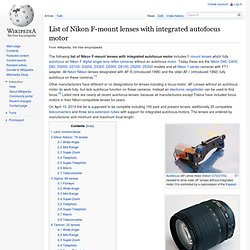
Today these are the Nikon D40, D40X, D60, D3000, D3100, D3200, D3300, D5000, D5100, D5200, D5300 models and all Nikon 1 series cameras with FT1 adapter. All Nikon Nikkor-lenses designated with AF-S (introduced 1996) and the older AF-I (introduced 1992) fully autofocus on these cameras.[1] Other manufacturers have different or no designations for lenses including a focus-motor. Best of the Best Nikkor Lenses. Best of the Best : A not-too-serious compilation of the best Nikkor lenses Compiled by Bjørn Rørslett The most common question I receive from all you people out there is simply this: Which is the best performing Nikkor of them all?

Of course, this is a nonsensical question. You cannot legitimately compare a wide-angle with a telephoto lens. Some of these groups should be populated with additional lenses of similar quality, this in particular applies to the 85-200 mm and long lens areas. The position of a lens in each category is mainly a matter of taste or needs and should not be taken as set in stone. The lens review pages will provide further details of all these lenses. . | Lens Survey | My Equipment |
Wide-Angle Lenses For Nikon 'F' Mount. Nikon pushes its optical program towards even shorter focal lengths with this ultrawide-angle lens.
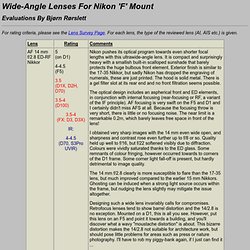
It is compact and surprisingly heavy with a smallish built-in scalloped sunshade that barely protects the huge bulbous front element. Exterior finish is similar to the 17-35 Nikkor, but sadly Nikon has dropped the engraving of numerals, these are just printed. The hood is solid metal. There is a gel filter slot at its rear end and no front filtration seems possible. The optical design includes an aspherical front and ED elements, in conjunction with internal focusing (rear-focusing or RF, a variant of the IF principle).
I obtained very sharp images with the 14 mm even wide open, and sharpness and contrast rose even further up to f/8 or so. The 14 mm f/2.8 clearly is more susceptible to flare than the 17-35 lens, but much improved compared to the earlier 15 mm Nikkors. Designing such a wide lens invariably calls for compromises. Meanwhile, read the full review here. Normal Lenses For Nikon 'F' Mount. An update of the older "screwdriver" 50/1.4 Nikkor was long overdue.
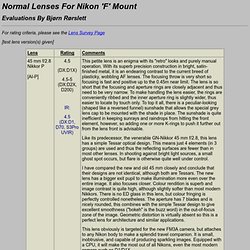
The new model, largely finished in lightweight material of an organic nature, sports an improved 8/7 optical design and at last, AFS operation. But unlike other recent new Nikkors, there is no nano-coating and no ED glass inside. While the lens barrel does not extend during focusing, there is no internal focusing (IF) to work its magic (and sometimes, adding colour aberrations) - the inner unit moves back and forth as an entity. Thus, the autofocus operational speed won't set a world record, but for most purposes it suffices well enough. Nikonians: Nikon Micro lenses options. I have used the Tokina AT-X 280AF Pro lens for approximately three months and in those three months I have taken quite a few photos with this lens, and it has developed into the standard lens on one of my camera bodies.

The 270AF Pro II lens I have had for a few years, and like the 280AF Pro lens, it was on one camera body at all times, that is, until I purchased the 280AF Pro lens. I originally purchased the 280AF Pro lens to supplement the 270AF Pro II lens, not to replace it. However, that was when I had three camera bodies, now that I have two, I may sell the 270AF Pro II lens, but not at this time.
Both lenses are internal focus, which means the lens stays the same size throughout the focusing range and the barrel of the lens does not rotate. This allows the use of special effects and polorizer filters without having to readjust them each time you change focus. One feature that I appreciate about the newer Tokina AT-X Pro Series lenses is that they all take a 77mm filter.
Nikon Lens - SLRgear.com! Ken Rockwell: Nikkor Lens Technology. This free website's biggest source of support is when you use any of these links when you get anything, regardless of the country in which you live.
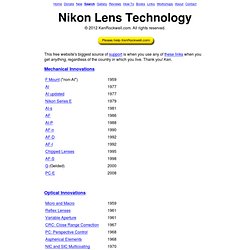
Thank you! Ken. Mechanical Innovations Optical Innovations. Nikkor Lens Information by Thom Hogan. That New AF-S ED-IF G VR PC DC DX Nikkor is a What?
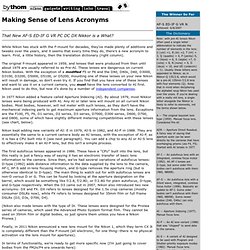
While Nikon has stuck with the F-mount for decades, they've made plenty of additions and tweaks over the years, and it seems that every time they do, there's a new acronym to learn. First, a little history, then the translation dictionary (right column). The original F-mount appeared in 1959, and lenses that were produced from then until about 1979 are usually referred to as Pre-AI. These lenses are dangerous on current Nikon bodies.